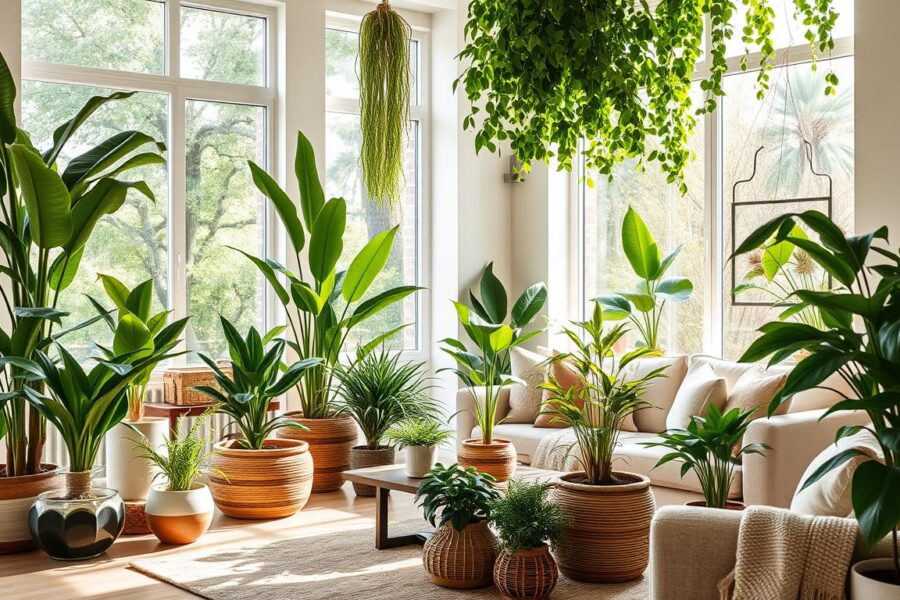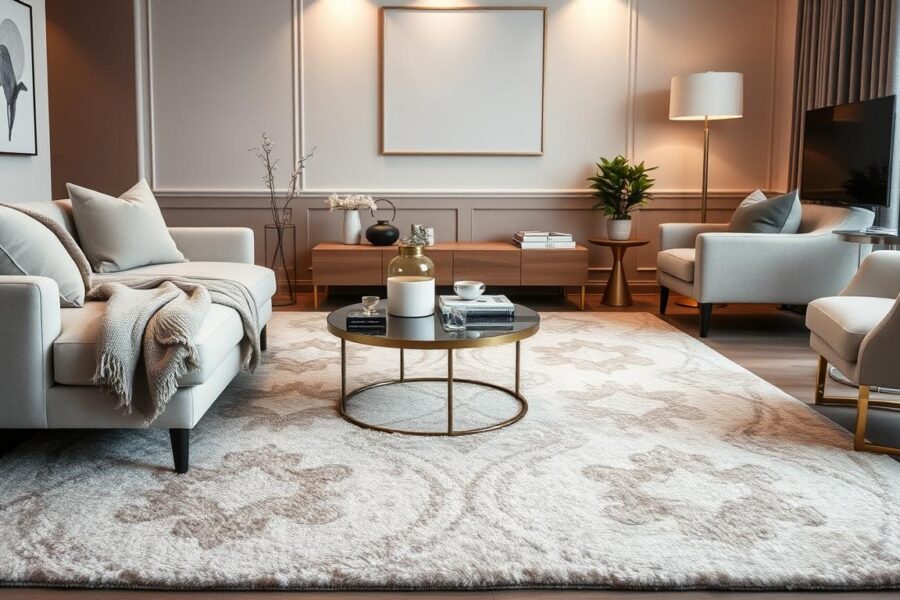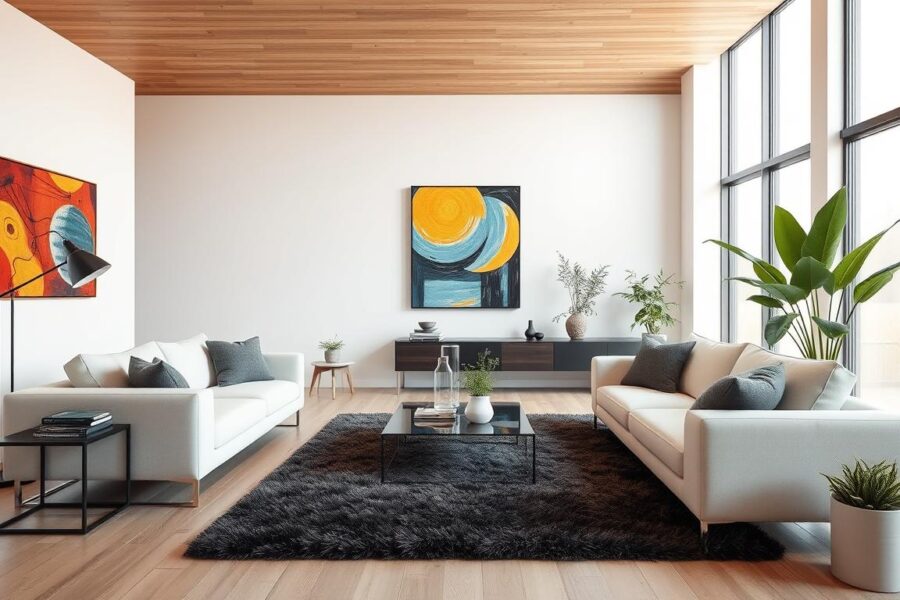This post contains affiliate links. Some images may have been created with the help of AI.
Imagine a living room where every item and color on the walls makes your space better and the planet healthier. Sustainable decor is now a big choice for those who care about the environment. You can find furniture made from bamboo that grows fast1 and LED lights that save money1.
Adding natural materials and ethical decor to your home is more than just making it look good. It’s a big step to reduce harm to the planet. For example, recycling and buying second-hand items can help a lot1. Organic cotton and sustainable wool also offer comfort without harming the environment.
Step into a world where your choices make a difference. Brands like West Elm use sustainable wood for half of their furniture2. Even choosing eco-friendly candles can help. It’s about creating spaces that reflect your values.
Start your journey to a more responsible home with our 25 sustainable decor choices. From luxurious rugs to multi-functional kitchen items, you can make your home a sanctuary. Begin today.
Understanding Sustainable Living Room Decor
Exploring sustainable living room decor means finding ways to help the environment, improve health, and look good. It’s about picking products that are eco-friendly and creating a peaceful, natural vibe in our homes.
What is Sustainable Decor?
Sustainable decor uses strategies and materials that are kind to our planet. It focuses on zero waste design, ethical decor, and sustainable living ideas. It uses recycled glass, bamboo, and reclaimed woods because they’re good for the environment and last a long time.
Bamboo and reclaimed wood are not only strong but also show off sustainable style. They make spaces that are both modern and timeless.
Why Choose Sustainability for Your Living Room?
Choosing sustainable designs in the living room helps us live healthier and more ethically. The Environmental Protection Agency found that furniture waste is huge, with only 18% being recycled3. On the other hand, using energy-efficient lighting like LED bulbs can save a lot of money and energy3.
Also, sustainable decor makes our homes feel calm and well. It’s all about creating spaces that are good for us and the planet.
| Material | Benefits | Usage in Decor |
|---|---|---|
| Bamboo | Eco-friendly, durable | Flooring, furniture |
| Reclaimed Wood | Reduces landfill waste, aesthetically pleasurable | Wall panels, furniture |
| Recycled Glass | Low impact on environment | Decorative items, countertops |
| Mycelium Leather | Biodegradable, sustainable | Furniture upholstery, decorative pillows |
By choosing sustainable interior design practices, we make our homes look better and are part of a big trend4. Sustainable living room designs are all about being useful, sourced ethically, and gentle on the environment. They make sure our homes are good for us and the planet.
Eco-Friendly Furniture Options
Choosing eco-friendly furniture is key to sustainable living room decor. It makes your space look great and helps the planet. You get to pick furniture that’s both stylish and kind to the environment.
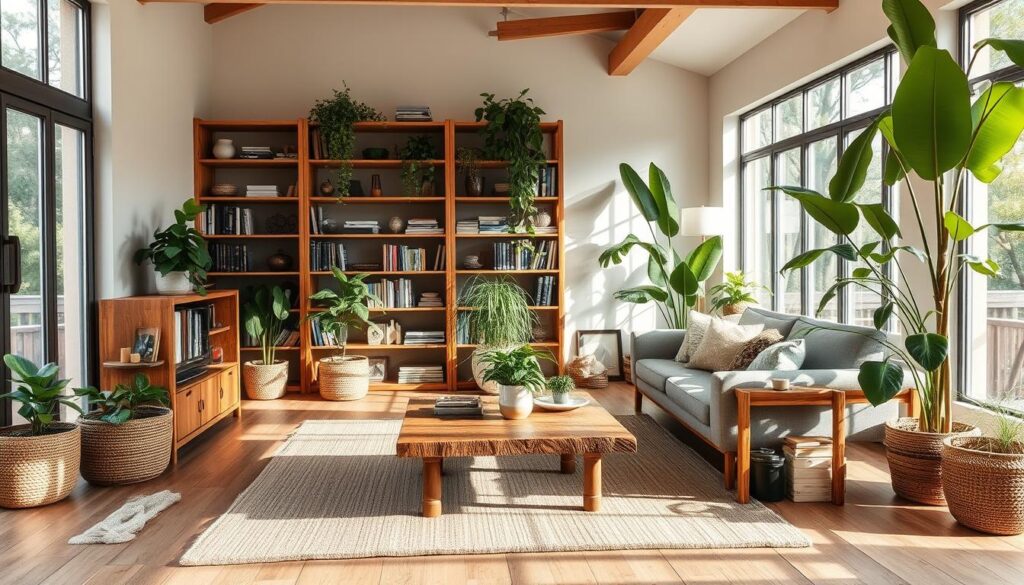
Reclaimed Wood Furniture
Reclaimed wood furniture is a big win for the planet. It means no new trees are cut down, saving forests. Brands like Avocado Furniture lead the way, making pieces in California from 100% reclaimed wood5.
Things like coffee tables and bookshelves from reclaimed wood are not only beautiful. They’re also very durable and have a timeless appeal.
Bamboo Furniture Choices
Bamboo is great because it grows fast and can be harvested sustainably. It’s used to make everything from armchairs to kitchen tables. Sabai Furniture loves bamboo for its strength and low environmental impact5.
Second-Hand Finds
Using second-hand items is a smart move. It cuts down on new material demand, pollution, and waste. Etsy is full of upcycled furniture from around the world, adding a unique touch to your sustainable living room decor5.
By picking eco-friendly furniture, you make your living space look good and help the planet. These choices help keep our environment healthy and balanced.
Wall Art with a Conscience
Adding eco-friendly wall art to your living room does more than just look good. It also helps the planet. Choose art made from recycled materials to add a unique touch to your home while being kind to the environment.
Upcycled Art Creations
Upcycled art turns old materials into beautiful pieces. It’s a great way to recycle and show off creativity. From colorful collages to metal sculptures, each piece has its own story.
Local Artisan Pieces
Buying art from local artists helps the local economy and cuts down on carbon emissions. They often use eco-friendly materials like organic paints. Plus, their work adds a personal touch to your home, showing off the local culture.
Nature-Inspired Prints
Nature prints bring a calm vibe to your living room. They feature scenes like forests and landscapes. These prints make your space look better and feel more peaceful.
| Material | Source | Impact |
|---|---|---|
| Reclaimed Wood | Local Artisans | Reduces waste, supports local crafts |
| Organic Paints | Sustainable Suppliers | Low environmental impact |
| Recycled Metals | Upcycled Crafts | Decreases industrial waste |
Choosing wall art with care can make your space more beautiful and help the planet. Every piece, whether a print or a sculpture, supports green living and makes a difference in your home6.
Sustainable Rugs and Textiles
Exploring eco-friendly living spaces, we focus on natural materials. We look at sustainable rugs and textiles. These items add beauty and follow environmental and ethical decor rules.
Organic Cotton and Linen Rugs
Organic cotton and linen rugs are soft yet strong. They’re perfect for those wanting eco-friendly furniture. These materials grow without bad chemicals, making them safe and comfy.
Non-Toxic Dyes in Fabrics
Sustainable fabrics use non-toxic dyes to keep colors bright and safe. This method cuts down on pollution, helping the environment.
Sustainable Wool Options
Wool rugs are durable and natural. They last long and are good for the planet. They come from places that care for animals and the land.
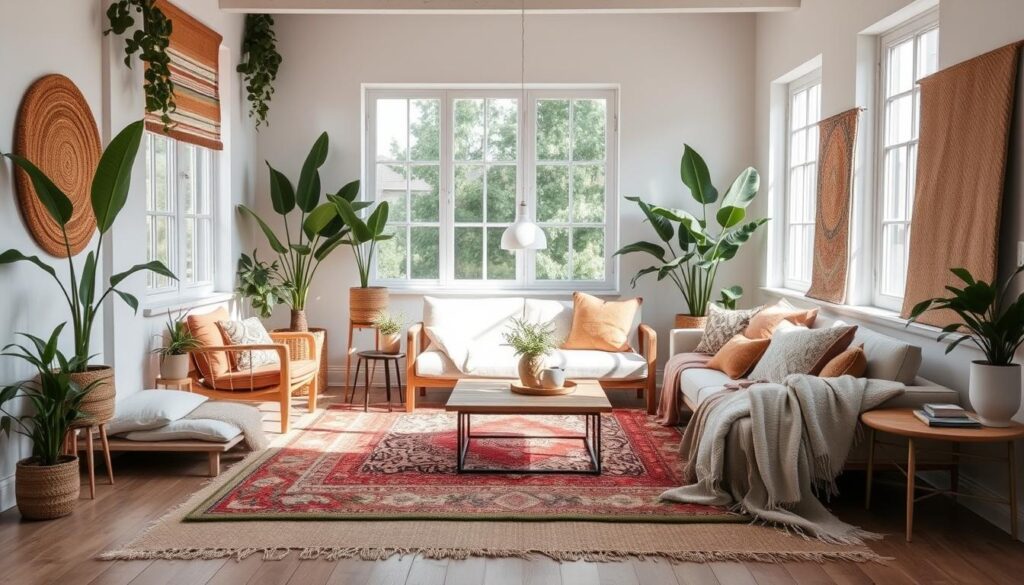
| Sustainability Features | Percentage |
|---|---|
| Brands Using Sustainable Materials | 100%7 |
| Rug Brands Focused on Fair Trade | 45%7 |
| Brands Offering Recycled Fibers | 36%7 |
| BIPOC-owned Brands | 9%7 |
Choosing sustainable rugs and textiles helps make our homes greener. Opting for organic cotton, linen, and wool from good sources, and dyes that are safe, makes our homes stylish and eco-friendly.
Green Plants as Decor
Adding green plants to your home makes it look better and is good for your health. It also helps make your living space more sustainable. Plants in indoor spaces help meet many Sustainable Development Goals (SDGs), making them key for sustainable living8.
Benefits of Indoor Plants
Indoor plants make your home healthier and more welcoming. They can lower stress, anxiety, and fatigue. They also boost your mood and brain function89.
Plus, plants can make you more productive and creative. This makes your home more lively and efficient89.
Low-Maintenance Plant Choices
Picking the right plants for your eco-friendly living room is key. Plants like pothos and snake plants do well in low light. Succulents and cacti are great for dry air. These plants need little care, perfect for those with busy lives or who are new to gardening9.
How to Choose Sustainable Pots
Choosing the right pots for your plants is just as important as picking the plants. Look for pots made from biodegradable materials or repurposed items. New materials make pots that are good for the environment and stylish. They fit well with any natural living room decor9.
Greenery in your home not only looks good but also improves air quality and saves energy. By picking the right plants and pots, you can turn your living room into a green oasis. It will be a place that promotes health and fits with eco-friendly living room ideas8.
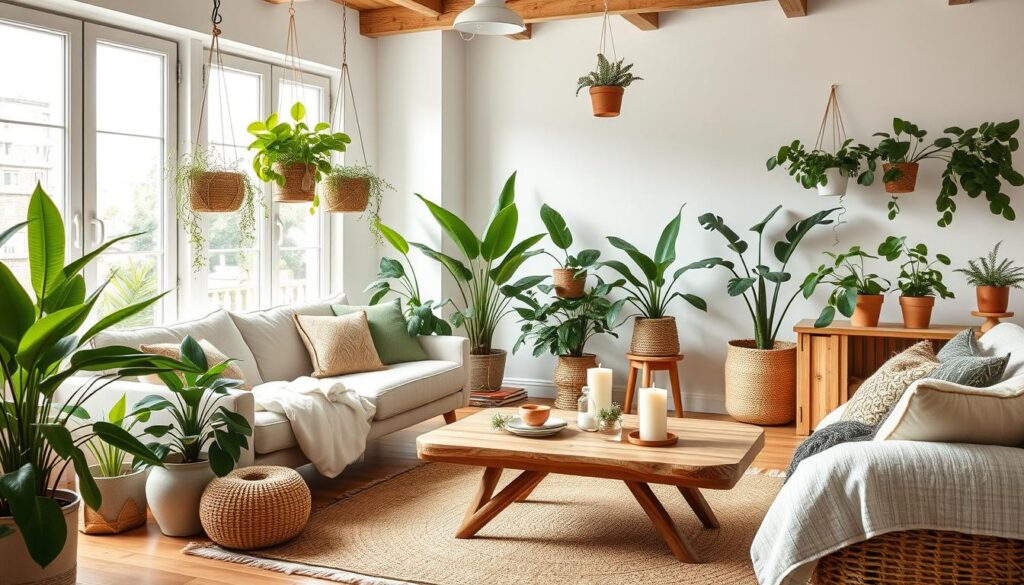
Lighting that Saves Energy
In today’s world, we focus on saving energy and being eco-friendly. Choosing the right lighting is key to green interiors. It helps save energy and makes your space look great.
LED Lighting Solutions
LED lights are long-lasting and save a lot of energy. They use 90% less energy than old bulbs and can cut down your bills by $100 a year10. By 2027, using LEDs could save a huge amount of electricity, saving money and the planet10.
Solar-Powered Options
Solar lights are a mix of new tech and green energy. They use the sun and don’t need the grid. They’re perfect for outdoor spaces, adding style and saving energy11.
Vintage Light Fixtures
Using old lights is a smart, stylish choice. It’s good for the planet and looks great. These lights are often made from recycled materials.
| Lighting Type | Price Range |
|---|---|
| LED Lights | $20 – $30010 |
| Handmade Table Lamps | $175 – $1,25012 |
| Solar-Powered Lights | Varies, often included with hardware11 |
| Vintage & Secondhand Lights | $10 – $50,00012 |
| Brass Sconces | $44.99 – $199.9912 |
Choosing energy-saving lights shows you care about the planet. It also makes your space unique and welcoming.
Choosing Eco-Conscious Decor Accents
Choosing eco-friendly decor is key to a sustainable lifestyle. It makes your living room look great and supports green living. Items like sustainable candles, biodegradable decor, and fair trade accessories help the planet and keep your decor stylish.
Choosing sustainable candles is a smart move. They’re made from natural waxes, burn clean, and are good for the planet. Plus, they’re healthier for your air and make your space cozy.
Sustainable Candles
Soy or beeswax candles are eco-friendly and brighten any room. They’re better for the environment than paraffin candles. They make your space look good and support green living.
Biodegradable Decorative Items
Using biodegradable decorative items helps reduce waste. Natural fiber throw pillows and biodegradable vases are perfect for ethical decor. They’re beautiful and won’t harm the planet.
Fair Trade Accessories
Fair trade accessories come from places that treat workers right. They add a special touch to your room and help communities grow. Choosing fair trade helps the world be a better place13.
Your decor choices affect the planet and people. By choosing sustainable living room decor, you help the environment and society. Every item, like a candle or pillow, can make a big difference in green living.
Color Choices for a Sustainable Look
Adding sustainable living ideas to your home is more than just picking eco-friendly items. It’s also about choosing colors that show care for the environment. Green interiors use colors that are not only beautiful but also sustainable. They often use natural materials and processes.
Earthy Tones
Choosing earthy tones is a big step towards green interiors. Colors like soft greens, muted browns, warm sands, and deep blues are inspired by nature. They make any room feel calm and connected to the earth, while showing off sustainable living ideas.
Eco-Friendly Paints
Eco-friendly paints are key in green interiors. They help reduce harmful emissions in your home. Low-VOC and natural paints are popular for their gentle impact on air quality. They’re a must for anyone who cares about health14.
Natural Stains and Finishes
Natural stains from plants and minerals are becoming more popular. They add beauty and durability without harmful chemicals. This makes your home a safe and sustainable space14.
Repurposing and DIY Decor
Exploring repurposing and DIY decor boosts creativity and supports sustainable living room decor. It focuses on eco-friendly furniture and upcycled ideas. These choices help the environment.
Upcycling Old Items
Millions of tons of furniture are thrown away each year, says the Environmental Protection Agency15. Upcycling gives old items a new life, cutting down on waste. It also saves raw materials.
This trend brings a unique look to homes. It adds charm and nostalgia from the past. This makes eco-friendly furniture popular in modern design15.
Creative DIY Projects
HomeAdvisor says upcycled materials can save up to 50% on renovation costs15. These projects are a fun way to make something unique. They turn everyday items into special room elements.
For example, old ladders can become bookshelves. Used barrels can be coffee tables. These ideas make a space look and function better16.
Community Workshops for Inspiration
Community workshops offer inspiration and support for upcycled ideas. They teach about reducing waste and being resourceful. You learn by doing.
Turning old items into decor strengthens their value. It connects them to learning and community experiences16.
| Material | Usage | Cost Efficiency | Sustainability Factor |
|---|---|---|---|
| Reclaimed wood | Furniture, wall art | High | Reduces deforestation |
| Bamboo | Accessories, furniture | Medium | Fast regrowth rate |
| Recycled metals | Decorative accents | Varies | Minimizes ore mining |
Sourcing Sustainable Materials
Choosing the right materials for your living room is more than just making it look good. It’s about helping the planet too. Ethical decor, with its focus on responsible sourcing and zero waste, is key to eco-friendly homes.
Importance of Certifications
Certifications show if home decor is good for the environment. They make sure materials are gathered in a green way and workers are treated right. The Citizenry, for example, pays artisans more than fair trade wage17, showing the good of ethical standards.
Finding Local Suppliers
Buying from local suppliers has many benefits. It uses materials from nearby, cutting down on transport pollution. Parachute, for example, makes products in the US and other places, choosing local when it can17.
Understanding the Life Cycle of Products
Real ethical decor looks at a product’s whole life. From raw material to end use, it aims for zero waste. LIKHÂ, for instance, makes sure many artisans in the Philippines get paid well17, helping their community.
Working with companies like Ten Thousand Villages also helps. They support thousands of makers in 30 countries17, showing a dedication to fair work and materials.
In short, using natural materials, looking for certifications, and knowing a product’s life cycle are crucial. This approach not only fits with ethical decor but also helps the world economically and environmentally.
Creating a Comfortable Atmosphere
The living room is the heart of the home, where we relax and enjoy beauty. People are now using biophilic design and green interiors to make these spaces special. Adding natural elements makes a room cozy and peaceful, perfect for unwinding18.
These spaces look great and feel right, connecting us to nature. It’s not just about looks; it’s about feeling a deep connection to the outdoors.
Biophilic Design Principles
Modern minimalism and biophilic design create calm spaces. They let in lots of natural light, boosting mood and energy18. Adding plants improves air and reduces stress, fitting with the trend of green interior elements19.
Using plants with simple colors or cool blues brings peace and harmony18.
Mindful Space Planning
Space planning is more than furniture placement. It’s about making the room fit its purpose, like a cozy reading nook or colorful rugs18. It’s about mixing styles to create a welcoming space for both chillout and socializing18.
Balancing Functionality and Aesthetics
Combining function and beauty means embracing eclectic styles. This allows for personal touches and warmth, while also supporting sustainability18. Mixing decor shows off individuality, turning a room into a special experience that boosts well-being18.

